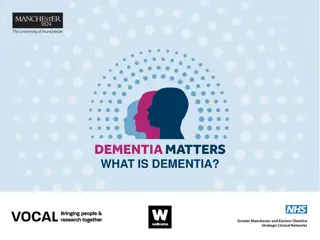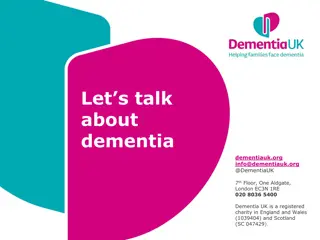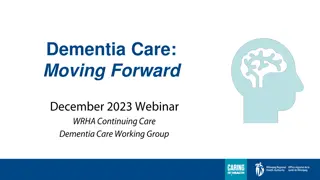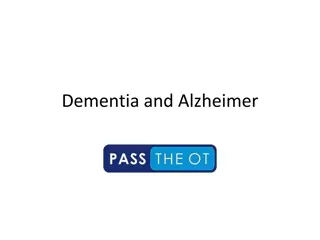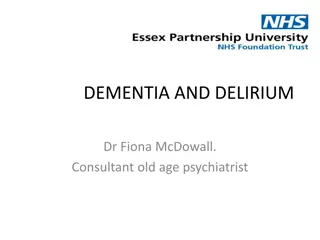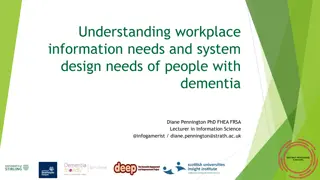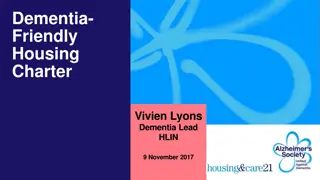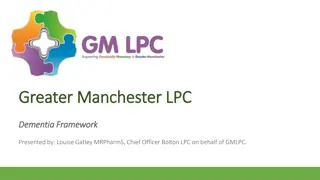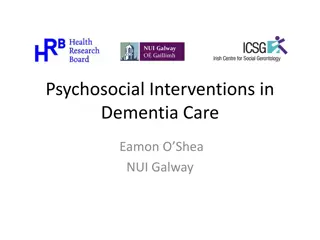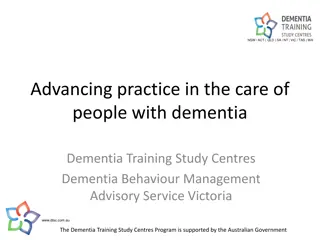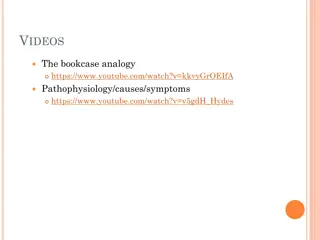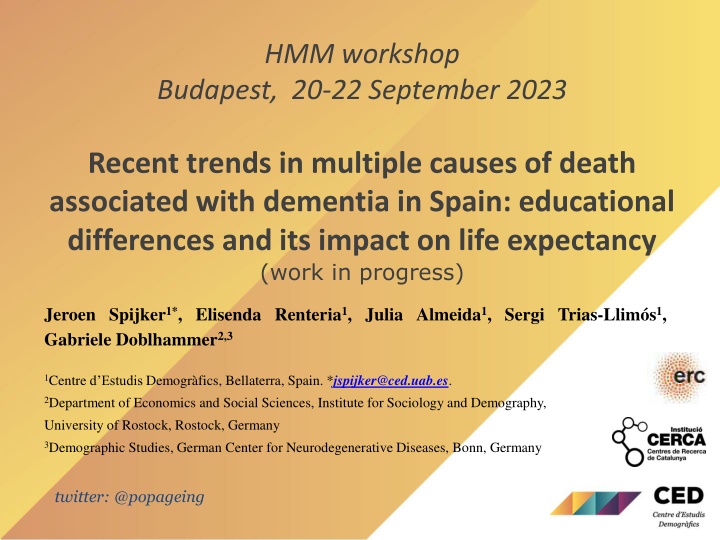
Recent Trends in Dementia-Related Mortality and Educational Impact in Spain
Explore recent trends in dementia-related mortality and its impact on life expectancy in Spain, focusing on educational differences. This study analyzes data from 2016 to 2021 to understand the multiple causes of death associated with dementia. Join us at the HMM Workshop in Budapest on 20-22 September 2023 for insights into this important research topic.
Download Presentation

Please find below an Image/Link to download the presentation.
The content on the website is provided AS IS for your information and personal use only. It may not be sold, licensed, or shared on other websites without obtaining consent from the author. If you encounter any issues during the download, it is possible that the publisher has removed the file from their server.
You are allowed to download the files provided on this website for personal or commercial use, subject to the condition that they are used lawfully. All files are the property of their respective owners.
The content on the website is provided AS IS for your information and personal use only. It may not be sold, licensed, or shared on other websites without obtaining consent from the author.
E N D
Presentation Transcript
HMM workshop Budapest, 20-22 September 2023 Recent trends in multiple causes of death associated with dementia in Spain: educational differences and its impact on life expectancy (work in progress) Jeroen Spijker1*, Elisenda Renteria1, Julia Almeida1, Sergi Trias-Llim s1, Gabriele Doblhammer2,3 1Centre d Estudis Demogr fics, Bellaterra, Spain. *jspijker@ced.uab.es. 2Department of Economics and Social Sciences, Institute for Sociology and Demography, University of Rostock, Rostock, Germany 3Demographic Studies, German Center for Neurodegenerative Diseases, Bonn, Germany twitter: @popageing
Background (I) Current improvements in life expectancy in highly-aged societies are dominated by the rapidly declining death rates among the elderly. These declines go along with changes in the cause-of-death structure Today s disease burden mainly comes from non-communicable diseases (NCD). Survival for patients suffering from cardiovascular diseases (CVD) and cancer, the two leading NCD, have greatly improved (due to in behaviour (diet, tobacco/alcohol consumption, physical exercise), more efficient healthcare system, improved diagnostic methods/medical treatment, tobacco control measures, ) other diseases have become more prevalent, especially those related to cognitive decline, incl. dementia. Although dementia deaths are increasing worldwide, this seems to be especially due to population ageing. Only a small part is caused by rising age-specific rates (GBD 2013). Alzheimer s disease and other dementias, age 70-79 both sexes, rate per 100,000 (% total mort): 1990: 362.8 (4.8%). 2013: 415.5 (6.3%). J Spijker et al twitter: @popageing HMM workshop 20-22 September 2023
Background (II) At older ages, multiple medical conditions are more common, in particular dealing with dementia/Alzheimer disease. Multiple cause of death (MCOD) data provides an excellent opportunity to improve our understanding of deaths from multimorbid conditions. Not surprisingly, MCOD data leads to much higher estimates of dementia/Alzheimer disease as these data measure indirectly related mortality not captured as underlying cause of death. e.g. 10000 dementia-related deaths were registered as UCOD in Australia in 2011 but 25000 if dementia was also considered as a contributory cause (ABS 2013), while in France and Italy it was underestimated by about half (D sesquelles et al 2014) J Spijker et al twitter: @popageing HMM workshop 20-22 September 2023
Objective To examine recent trends in dementia-related mortality from a multiple cause of death (MCOD) perspective and its impact on life expectancy at age 60, looking into educational inequalities therein. We do this for Spain for the period 2016-21. J Spijker et al twitter: @popageing HMM workshop 20-22 September 2023
Data and Methods (I) Mortality data from the Spanish National Statistics Institute (INE) from 2016 to 2021 We analyse mortality from dementia (ICD10 F01-F03, G30-G31) as underlying cause of death (UCOD) and MCOD (irrespective of their position within the death certificate). But the following UCOD of other important causes are also analysed when dementia is the contributing cause: J Spijker et al twitter: @popageing HMM workshop 20-22 September 2023
Data and Methods (II) Cause of death category ICD10 Dementia & Alzheimer s disease (anywhere on death certificate) F01-F03, G30-G31 Other causes as UCOD, excl. deaths with dementia as contributing cause Cancer Diabetes mellitus Parkinson s disease Circulatory system diseases Ischaemic heart disease Cerebrovascular disease including stroke Other circulatory system diseases Respiratory system diseases Chronic lower respiratory diseases Remaining respiratory system diseases Chronic liver disease and cirrhosis COVID-19 Other natural causes of death External causes of death Accidental falls Other external causes of death (C00-D49) (E10-E14) (G20-G21) (I00-I99) (I20-I25) (I60-I69) (Remainder of I00-I99) (J00-J99) (J40-J47) (Remainder of J00-J99) (K70, K73-K74) (U07.1, U07.2) (Remainder of A00-R99) (S00-Y98) (W00-W19) (Remainder of S00-Y98) J Spijker et al twitter: @popageing HMM workshop 20-22 September 2023
Data and Methods (III) Two educational groups (this will permit international comparative research at a later date): o Low education: lower secondary education or less (incl illiterates) o High education: upper secondary education or more <2% of the deaths did not have information on the educational level. These deaths were proportionally distributed among the two categories. J Spijker et al twitter: @popageing HMM workshop 20-22 September 2023
Data and Methods (IV) Age standardised mortality rates (for descriptive analysis) Using the decomposition by Horiuchi et al (2008) we calculate the contribution of dementia-related mortality based on underlying and contributing cause of death to the difference between life expectancy at age 60 between the most and least educated (educational gap)*. *Previously, we applied the same method on Covid-19: J Spijker et al twitter: @popageing HMM workshop 20-22 September 2023
Descriptive results ASMR of total mortality and from dementia. Per 1,000. Population aged 60+. Spain (2016-21) Men High Women High Total Low Total Low Total Mortality UCOD Dementia MCOD Dementia (incl. UCOD Dementia) 49.0 3.4 6.1 43.9 3.0 5.4 50.0 3.4 6.2 32.4 4.0 6.7 27.6 3.4 5.5 31.9 4.1 6.6 Men High Women High Total Low Total Low Total Mortality UCOD Dementia MCOD Dementia (incl. UCOD Dementia) 100% 7% 100% 7% 100% 7% 100% 13% 100% 13% 100% 13% 12% 12% 12% 21% 20% 21% J Spijker et al twitter: @popageing HMM workshop 20-22 September 2023
Dementia mortality rates (ln) by age groups over 60 years-old. Spain (2016-21) Men Women -2 -2 -3 -3 ASMR MCOD ASMR MCOD -4 -4 6.6 5.5 6.2 5.4 -5 -5 -6 -6 -7 -7 ASMR UCOD 4.1 3.4 ASMR UCOD 3.4 3.0 -8 -8 -9 -9 -10 -10 -11 -11 60-64 65-69 70-74 75-79 80-84 85-89 90-94 95 + 60-64 65-69 70-74 75-79 80-84 85-89 90-94 95 + Low education, MCOD Low education, UCOD Low education, MCOD Low education, UCOD High education, MCOD High education, UCOD HMM workshop 20-22 September 2023 High education, MCOD High education, UCOD J Spijker et al twitter: @popageing
Distribution of the underlying cause of death among deaths with dementia mentioned anywhere on death certificate. 60+ population, Spain (2016-2017) 7% 5% 7% 4% 4% 17% 4% 2% 6% 8% 7% 7% 7% 15% 18% 6% 4% 6% 6% 6% 4% 4% 17% 6% 6% 7% 15% 4% 15% 17% 16% 2% 7% 3% 4% 2% 7% 4% 3% 2% 63% < 63% 8% 58% 59% 58% 62% 62% Source: Elaborated based on mortality information from the Instituto Nacional de Estad stica (2023)
Distribution of the underlying cause of death among deaths with dementia mentioned anywhere on death certificate. 60+ population, Spain (2018-2019) 7% 4% 7% 6% 17% 6% 4% 6% 6% 15% 4% 2% 16% 4% 3% 15% 7% 3% 7% 4% < 65% 59% 64% 59% Source: Elaborated based on mortality information from the Instituto Nacional de Estad stica (2023)
Distribution of the underlying cause of death among deaths with dementia mentioned anywhere on death certificate. 60+ population, Spain (2020-2021) 7% 9% 2% 7% 10% 5% 7% 11% 2% 15% 5% 2% 7% 12% 4% 14% 17% 15% 4% 2% 6% 3% 6% 4% < 56% 56% 50% 51% Source: Elaborated based on mortality information from the Instituto Nacional de Estad stica (2023)
Distribution of the underlying cause of death among deaths with dementia mentioned anywhere on death certificate. 60+ population, Spain (2016-2021) 7% 3% 3% 7% 4% 6% 7% 4% 3% 6% 5% 5% 15% 17% 15% 4% 2% 16% 4% 2% 7% 3% 7% 4% < 60% 55% 56% 61% Source: Elaborated based on mortality information from the Instituto Nacional de Estad stica (2023)
Main results. Decomposition of LE. Life expectancy at age 60 Spain (2016-2021) Men 23.02 Women 27.39 Total 24.17 28.59 High education 22.57 27.43 Low education Educational gap (high low) 1.61 1.16 J Spijker et al twitter: @popageing HMM workshop 20-22 September 2023
Dementia contribution to the educational gap in life expectancy at age 60 Spain (2016-2021) high low = 1.61 yrs UCOD effect: 0.07 yrs (4%) UCOD effect: 0.15 yrs (13%) MCOD effect: 0.13 yrs (8%) MCOD effect: 0.26 yrs (23%) Max %: age 95+ (14%) Max %: age 90+ (31%) high low = 1.16 yrs Source: Elaborated based on mortality information from the Instituto Nacional de Estad stica (2023)
Summary of results (2016-21 period) Dementia-related mortality based on MCOD is 45% (men) and 40% (women) higher than when only the UCOD is used. 17% of mortality among the 60+ is dementia-related. Men: 12%, women 21%), but there are no educational differences in terms of relative proportions. Causes of death closely linked to dementia include circulatory system diseases (15% of male/17% of female deaths had dementia as contributing cause), cancer (7%/4%) and respiratory system diseases (6%/4%). The contribution of dementia-related mortality to the 1.6 (male) and 1.2 (female) year educational gap in life expectancy is 8% (men) and 23% (women) (up to 31% in the case of 90+ year-old women). J Spijker et al twitter: @popageing
Summary of results effect of COVID (2020-21) Dementia-related mortality based on MCOD is 50% (men) and 44% (women) higher than when only the UCOD is used. 16% of mortality among the 60+ is dementia-related. Men: 12%, women 20%), but there are no educational differences in terms of relative proportions. Causes of death closely linked to dementia include circulatory system diseases (15% of male/15% of female deaths had dementia as contributing cause), COVID (11%/10%) cancer (6%/4%) and respiratory system diseases (5%/2%). The contribution of dementia-related mortality to the 1.6 (male) and 1.2 (female) year educational gap in life expectancy is 8% (men) and 21% (women) (up to 34% in the case of 90+ year-old women). J Spijker et al twitter: @popageing
Discussion Analysing all causes that mention dementia on the death certificate provides a more realistic estimate of the real impact of dementia on total mortality and life expectancy. It also allows the researcher to study the diseases that are associated with dementia. The MCOD approach is therefore a valuable tool to gain insights into the burden of ageing-related diseases. We found few educational differences in dementia COVID also did not alter ASMR from dementia when MCOD was considered, otherwise rate would have been slightly lower. Our study was cross-sectional, so what about future trends? According to Doblhammer et al (2015), trends in medical, lifestyle, and societal risk factors of dementia may have contributed to observed declines in prevalence and incidence in dementia in Germany. Should we be cautiously optimistic? But we need to die of something, right? J Spijker et al twitter: @popageing HMM workshop 20-22 September 2023
References Australian http://www.abs.gov.au/AUSSTATS/abs@.nsf/DetailsPage/3303.02011?OpenDocument. D sesquelles A, Demuru E, Salvatore MA, et al. Mortality from Alzheimer s disease, Parkinson s disease, and dementias in France and Italy: a comparison using the multiple cause-of-death approach. J Aging Health. 2014;26(2):283-315. Doblhammer G, Fink A, Zylla S, Willekens F (2015). Compression or expansion of dementia in Germany? An observational study of short-term trends in incidence and death rates of dementia between 2006/07 and 2009/10 based on German health insurance data. Alzheimer's research & therapy, 7(1), 1-11. GBD 2013 Mortality and Causes of Death Collaborators (2015). Global, regional, and national age sex specific all-cause and cause-specific mortality for 240 causes of death, 1990 2013: a systematic analysis for the Global Burden of Disease Study 2013. Lancet, 385, 117-171. Horiuchi S., Wilmoth J.R., Pletcher S.D. (2008). A decomposition method based on a model of continuous change. Demography, 45(4), 785-801. INE. Death statistics according to cause of death. Methodology (2020) Madrid: INE (Instituto Nacional de Estadistica). https://www.ine.es/en/daco/daco42/sanitarias/metodologia_00_en.pdf INE. Asignaci n de nivel educativo, relaci n con la actividad laboral y ocupaci n a ficheros de Movimiento Natural de la Poblaci n (MNP). M todo de obtenci n y advertencias a usuarios (2020). Madrid, Spain: INE (Spanish National Statistics Institute). https://www.ine.es/metodologia/t20/Nota_meto_MNP.pdf Olshansky SJ, Ault AB (1986). The fourth stage of the epidemiologic transition: The age of delayed degenerative diseases. The Milbank Memorial Fund Quarterly. 1986;64(3):353-91 Spijker J, Trias-Llim s S (2023), Cause-specific mortality in Spain before and during the pandemic: educational differences and its impact on life expectancy using multiple causes of death data. European Journal of Public Health, ckad036, https://doi.org/10.1093/eurpub/ckad036 Trias-Llim s S, Spijker J (2022). Educational differences in alcohol-related mortality and their impact on life expectancy and lifespan variation in Spain (2016 2018): a cross-sectional analysis using multiple causes of death. BMJ Open, 12:e053205. https://doi.org/10.1136/bmjopen-2021-053205 Tsai S.P., Lee E.S., Hardy R.J. (1978). The effect of a reduction in leading causes of death: potential gains in life expectancy. American Journal of Public Health, 68(10), 966-971. Bureau of Statistics (ABS) (2013). Causes of Death, Australia, 2011. Available from: J Spijker et al twitter: @popageing HMM workshop 20-22 September 2023
Acknowledgements This work was supported by the research project The health of people in advanced ages: the analysis of comorbidity, multiple causes of death and gender and socioeconomic inequalities in health (COMORHEALTHSES) (PI: JS, Co-PI: ER), funded by the Spanish Ministry of Science and Innovation (PID2020-113934RB-I00). ER and STL also acknowledge research funding from the same Ministry (RYC2021-033123-I; RYC-2017- 22586) and JA and JS from the European Research Council (ERC-2019- COGagreement No 864616, HEALIN). Funding also comes from the Catalan Government under the CERCA programme. J Spijker et al twitter: @popageing
You want to know more about what we do on MCOD ? R&D project on The health of people in advanced ages: the analysis of comorbidity, multiple causes of death and gender and socioeconomic inequalities in health (COMORHEALTHSES) * (PI: JS, Co-PI: ER). Objective 2: To provide an accurate estimate of recent trends in old-age mortality from ageing-related diseases based on multiple cause of death data Trias-Llim s S et al (2023). Frailty at death: An examination of multiple causes of death in four low mortality countries. Demographic Research 49(2):13-30. https://doi.org/doi:10.4054/DemRes.2023.49.2 Trias-Llim s S, Permanyer I (2023). Cause-of-Death diversity from a Multiple-Cause Perspective in the United States. Demography 60(1):73-98. https://doi.org/doi:10.1215/00703370-10410415 Trias-Llim s S, Spijker J (2022), Educational differences in alcohol-related mortality and their impact on life expectancy and lifespan variation in Spain (2016 2018): a cross-sectional analysis using multiple causes of death. BMJ Open, 12:e053205. https://doi.org/10.1136/bmjopen-2021-053205 Spijker J, Trias-Llim s S (2023), Cause-specific mortality in Spain before and during the pandemic: educational differences and its impact on life expectancy using multiple causes of death data. European Journal of Public Health, 33(3):543-549, https://doi.org/10.1093/eurpub/ckad036 * funded by the Spanish Ministry of Science and Innovation (PID2020-113934RB-I00). HMM workshop 20-22 September 2023 J Spijker et al twitter: @popageing
Thank you! Jeroen Spijker Elisenda Renteria Julia Almeida Sergi Trias-Llim s Gabriele Doblhammer Email: jspijker@ced.uab.es Twitter @popageing
What are dementias? Alzheimer s disease (AD) is the most common form of dementia, accounting for 50 70% of cases. * Source: Doblhammer et al. 2017; Winbladt et al. 2016
Descriptive results ASMR of total mortality and from dementia. Per 1,000. Population aged 60+. Spain (2020-21) Men High Women High Total Low Total Low Total Mortality UCOD Dementia MCOD Dementia (incl. UCOD Dementia) 51.1 3.1 6.2 43.9 2.8 5.6 50.0 3.2 6.3 33.6 3.8 6.8 29.2 3.2 5.8 33.6 3.8 6.8 Men High Women High Total Low Total Low Total Mortality UCOD Dementia MCOD Dementia (incl. UCOD Dementia) 100% 6% 100% 6% 100% 6% 100% 11% 100% 11% 100% 11% 12% 12% 12% 20% 20% 20% J Spijker et al twitter: @popageing HMM workshop 20-22 September 2023
Main results Life expectancy at age 60 Spain (2016-2017) Men 23.09 Women 27.44 Total 24.35 28.74 High education 22.83 27.65 Low education Educational gap (high low) 1.52 1.10 J Spijker et al twitter: @popageing HMM workshop 20-22 September 2023
Main results Life expectancy at age 60 Spain (2018-2019) Men 23.33 Women 27.65 Total 24.51 28.89 High education 22.83 27.66 Low education Educational gap (high low) 1.68 1.23 J Spijker et al twitter: @popageing HMM workshop 20-22 September 2023
Main results Life expectancy at age 60 Spain (2020-2021) Men 22.62 Women 27.08 Total 23.66 28.14 High education 22.03 26.99 Low education Educational gap (high low) 1.62 1.15 J Spijker et al twitter: @popageing HMM workshop 20-22 September 2023
Dementia contribution to the educational gap in life expectancy at age 60 Spain (2016-2017) high low = 1.52 yrs UCOD effect: 0.08 yrs (5%) UCOD effect: 0.16 yrs (14%) MCOD effect: 0.14 yrs (9%) MCOD effect: 0.27 yrs (25%) Max %: age 95+ (12%) Max %: age 90+ (29%) high low = 1.10 yrs Source: Elaborated based on mortality information from the Instituto Nacional de Estad stica (2023)
Dementia contribution to the educational gap in life expectancy at age 60 Spain (2018-2019) high low = 1.68 yrs UCOD effect: 0.08 yrs (4%) UCOD effect: 0.17 yrs (14%) MCOD effect: 0.14 yrs (8%) MCOD effect: 0.28 yrs (23%) Max %: age 95+ (27%) Max %: age 90+ (29%) high low = 1.23 yrs Source: Elaborated based on mortality information from the Instituto Nacional de Estad stica (2023)
Dementia contribution to the educational gap in life expectancy at age 60 Spain (2020-2021) high low = 1.62 yrs UCOD effect: 0.06 yrs (4%) UCOD effect: 0.13 yrs (11%) MCOD effect: 0.13 yrs (8%) MCOD effect: 0.24 yrs (21%) Max %: age 95+ (5%) Max %: age 90+ (34%) high low = 1.15 yrs Source: Elaborated based on mortality information from the Instituto Nacional de Estad stica (2023)


